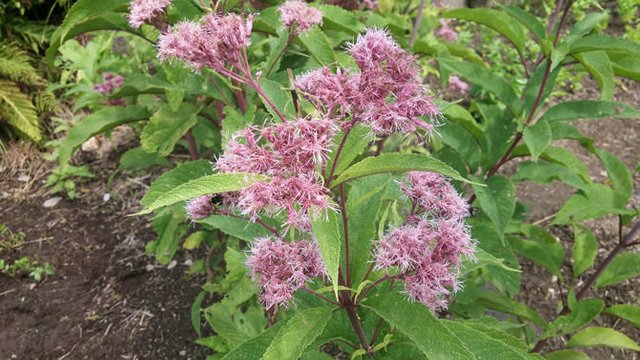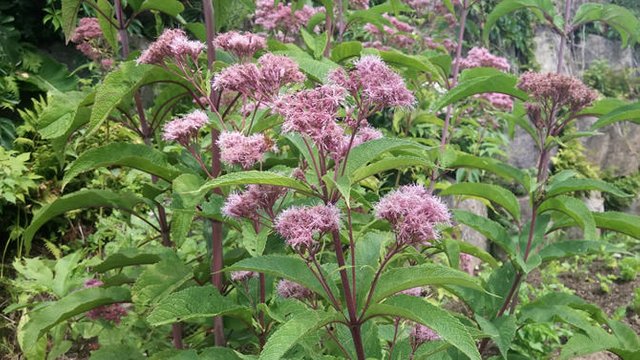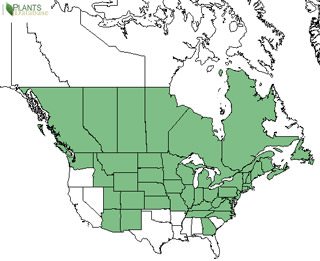Getting to Know Herbs: Joe-Pye Weed / Gravel Root
Joe Pye weed is a herbaceous perrneial plant that comes from the sunflower family, related to another flower recently covered, Boneset (Eupatorium perfoliatum).
The whole plant can be used. Leaves and stems are harvested in the summer before the flower buds open. Roots are harvested in the autumn. Fresh flowers can be used to make an herbal tea.

Photo by @krnel
There are two common types, one is a Sweet Joe-Pye Weed Eupatorium purpureum, and the other a Spotted Joe-Pye Weed Eutrochium maculatum. It's hard to find out which one is which though. Apparently the spotted one has spots, but I can't find clear images of the spots to differentiate. The spots are only seen when the plant is still green, but when completely purple there are no more spots.
Other namees include Eupatoire Pourpre, Herbe de Joe Pye, Kidney Root, Purple Boneset, Queen of the Meadow, Raíz de Eupatorio, Roter Wasserhanf, Trumpet Weed.

Photo by @krnel
Key Points
- whole plant can be used
- native to North America
- named after Native Amerindian with Christian name Joseph Pye
- used to treat kidney stones and fevers
History
The origin of the name Joe Pye comes from an Indian healer from New England named Jopi. He used the plant to treat various ailments. The folklore says he used it to cure fevers and typhus outbreaks in the 1800s.
Author Hemmerly wrote that the Native Amerindians sued it to treat kidney stones and other urinary tract infections.
A peer-review study suggests Joe Pye was a Mochican sachem named Schauquethqueat who lived in Stockbridge, Massachusetts from 1740 to 1785 and took on a Christian name of Joseph Pye.
Where is it found?
Joe Pye weed is native to North America, found across the Unites Stes and Canada.
It's found in moist woods, fields and marshes, damp thickets, and along streams. It does well in moist areas which include man-made ditches and seepage area. It flourishes in non-shaded areas that are also wetlands.
What's it used for?
The bulb, root, stem and leaves can be ground up to make medicine, or infused to make tinctures or teas.
It's used to treat urinary tract infections, kidney stones, infections of the bladder, urethra, and prostate; and painful urination. The name Gravel Root comes from it's use in treating kidney stones (gravel). In addition to being anti-lithic (dissolving kidney stones), it also has diuretic properties.
It also helps with cystitis, dysuria, urethritis, and pelvic inflammatory disease. It's said to tone the reproductive tract and used to treat inflammation of the prostate.
Other uses include treatment for arthritis-like pain (rheumatism), gout, and for fever from malaria, dengue virus, or typhus. It also reduces stomach acid, increase urine flow, cause vomiting, and cause sweating; and as a stimulant and tonic.
Are there any risks?
Joe Pye weed is considered toxic in causal or excessive use. It contains chemicals called hepatotoxic pyrrolizidine alkaloids (PAs) which can block blood flow in the veins and cause liver damage. HPAs might also cause birth defects or cancer.
Those allergic to the Asteraceae/Compositae plant family which include ragweed, chrysanthemums, marigolds, daisies, and many others should avoid the plant.
Joe Pye weed might decrease how well the body gets rid of lithium, increasing how much lithium is absorbed by the body and produce serious side effects. Some medicines that break down Joe Pye/ Gravel Root can enhance the toxicity of the plant, which includes carbamazepine (Tegretol), phenobarbital, phenytoin (Dilantin), rifampin, rifabutin (Mycobutin), and others.
References:
Previous posts on Getting to Know Herbs:
Valerian | Malva/Mallow | Boneset | Elecampane | Lungwort | Cramp Bark | Motherwort | Common Plantain | Eleuthero (Siberian ginseng) | Black Cohosh | Common Bearberry | Mahonia Mountain Grape (Oregon Grape) | Blue Cohosh | Goldenseal
Thank you for your time and attention. Peace.
If you appreciate and value the content, please consider: Upvoting, Sharing or Reblogging below.
 me for more content to come!
me for more content to come!
My goal is to share knowledge, truth and moral understanding in order to help change the world for the better. If you appreciate and value what I do, please consider supporting me as a Steem Witness by voting for me at the bottom of the Witness page.


Do you make tinctures yourself? My girlfriend does, although she hasn't in awhile. Once we get back on our feet she will get back into them again.
No, my girlfriend doesn't yet, but she will in the future when we grow things ourselves ;)
is this a diuretic? I saw a bunch of the plantain growing in a field the other day and thought of this series, thanks!
Yup, thanks for remarking on that. I read it but forgot to add, which I did now ;)
What a beautiful medicine plant.
I have not heard of this amazing plant before, so glad you shared it with us, since I love learning about the plant-based medicine which is amazing for our overall health.
Glad to provide some useful knowledge for you ;)
It is interesting how so many of these herbs are multi-purposed. That is what makes it beautiful. Thanks @krnel
Yup, most of them have many applications.
It is a nice photo
Posted using Partiko Android
Quite informative @krnel
👍
Iv'e heard the name but now I know what it looks like. :-)
Lot of health benefits of theGravel Root it used for urinary tract problems such as infections of the bladder, urethra, and prostate; enlarged prostate; and kidney stones. It is also used for hay fever.
If you would like to support the educational community by delegating to @steemiteducation, please click on any of the following links. This will ensure that more teachers are supported on a daily basis.
100SP 200SP 300SP 400SP 500SP 750SP 1000SP 2000SP 3000SP 4000SP 5000SP 10,000SP 25,000SP